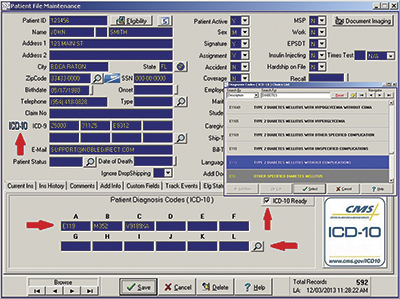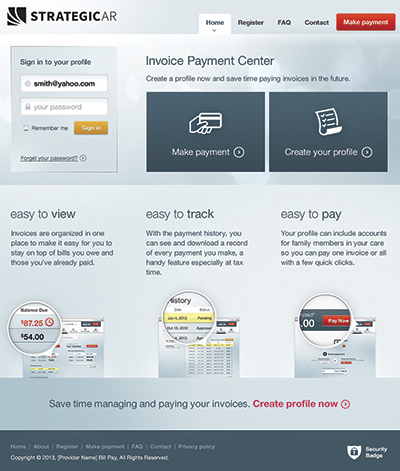As the average American life expectancy increases and more Americans become Medicare eligible in the coming years, HME providers are in a prime position to increase profits. However, with squeezed Medicare reimbursements and a slow-to-adapt patient base, HME businesses are looking, not only for new sources of income, but also for better technology to enable accurate inventory control and billing management. For patients and providers alike, the need is increasing for more intuitive—and vastly more efficient—billing management solutions.
Online Solutions for Tech-Savvy Patients
"If they haven't already, providers should start thinking about moving more of their business online to remain on the path of greater efficiencies, not only for themselves, but also for patient satisfaction," advises Jennifer Leon, director of marketing and customer service at Strategic AR. "When a company offers a platform such as a patient portal—allowing a patient to register an account, view and pay their bills online, as well as set up auto-pay functions and electronic delivery of invoices—patient loyalty increases." As the baby boomer population expands, the need for HME-oriented online shopping and online bill pay will also grow. Forward-thinking providers must look for technologies that both further their efficiencies and offer immediate patient convenience. "Online patient portals also offer a sense of transparency, so that the patient can manage their financial responsibilities, reorder supplies or check current orders online," Leon points out. Companies who provide online services will be one step ahead of the competition. Electronic billing, as well, presents multiple benefits for HME providers. "As reimbursements continue to be cut, providers have no option but to collect from the patient," says Leon. "By looking to billing software to help assist in the collection efforts, it is important to evaluate how easily other technologies may integrate and/or compliment the current platform." With technological tools that offer more automation, it's an opportune moment for providers to evaluate what might work best for their businesses.
Direct Patient Payment: The Way of the Future
Strategic AR—a Kansas-based company that helps connect HME providers with successful billing options—now offers a suite of solutions aimed at engaging the patient earlier in the billing process, securing an average of 72 percent more in private-pay collections. When providers utilize advanced technologies—such as Strategic AR's Virtual Agent (for billing reminder calls), Patient Portal (for online patient account management), and AutoPAY (for direct, 100 percent payment coverage)—they no longer have to engage their staff in the collections process, allowing employees to focus efforts on higher payoff activities. For example, Strategic AR's Patient Portal allows patients immediate access to their account management after registering. At a glance, they can view and pay invoices, set up AutoPAY and eDelivery of future invoices, and print copies of receipts for tax purposes. "As providers continue to fight to secure the patient-pay portion of their business, having AutoPAY functionality—as well as best practices wrapped around this strategy—will be crucial in securing 100 percent of the monies owed," says Leon. AutoPay automatically charges a card on file when an invoice is due, not only securing payment up front, but eliminating the need for past-due follow up. For providers who want to see how patients respond to AutoPAY, Leon suggests recurring rentals as a good testing place for this new payment strategy. AutoPAY takes the hassle out of trying to collect from the patient, guaranteeing timelier payments and a more efficient workflow.
 Billing software from Noble House
Billing software from Noble HouseThe Ease of Automation
"Long gone are the days and the time involved of manual processes," declares Leon. "Automation will be key amongst all departments, whether it's for billing specifically or related to other departments such as sales, operations, or deliveries. Providers who are forward thinkers and look to find technologies that can further their efficiencies will be the most successful in 2015." Jay Williams, national sales manager, Western Region, of South Carolina-based QS/1, agrees. "HME businesses are looking for new sources of income to replace Medicare Part B. They also need accurate inventory control and accounts receivable management, and an affordable HME program is vital to making this work for their businesses." Founded more than 40 years ago by a pharmacist with a passion for automation and a hunch that pharmacists needed electronic systems to help manage successful practices, QS/1 remains at the forefront of technology developed for the health care industry. QS/1 now offers a full-featured HME business management program called SystemOne, which is designed to support both pharmacies with small HME supply business and pharmacies with full HME departments. SystemOne allows the pharmacy to share the doctors and patient demographics between SystemOne and pharmacy programs NRx (retail HMEs) or PrimeCare (long-term care HMEs). "Pharmacies can enter HME sell-items directly into either of our pharmacy programs, which then automatically generate all the HME and Medicare Part B required documentation," says Williams. Claims are then automatically created in SystemOne for billing. Processing patient intakes and billing is another form of automation that benefits both patient and provider. "By now, most providers understand the cost of doing business in this industry. And they know what reimbursement rates are tolerable," says Gail Turner, HME software sales consultant with Computers Unlimited, whose TIMS Medical software forms all-in-one solutions for HME/DME providers. "For them to remain profitable, adjustments must be made to the way they do business, and a powerful ERP software solution is the answer here." New provider software, such as Computers Unlimited's TIMS Integrated Workflow, is designed to improve office efficiency by using a clear, intuitive on-screen status bar indicating the progress of each intake. This process allows the provider to measure customer service productivity and easily manage workload and work lists for CSRs. Most importantly, however, it helps CSRs quickly and easily identify priority orders—a critical component for both the process and for the patient. With intuitive software, providers can analyze everything—including profitability by payer, profitability by line of business, profitability by referral, and profitability by salesperson—to give a better overview of their business. "This is an opportunity to be strategic," advises Turner. "Know your numbers. Set benchmarks—find out where in the business you have room for improvement and opportunity for growth." Automation can be especially important in the increasingly common home health care environment. Mediware, a company that provides software solutions to manage patient care information across various segments of the care continuum, now offers mobile delivery applications that incorporate electronic signature capture for delivered products, as well as mobile data collection to increase efficiencies when providing service in the patient home environment. "This means there is no duplication of data entry," says Kim Commito, product manager of home care solutions at Mediware. "Services delivered to a patient are carried seamlessly through the billing process, producing standard electronic claims for processing with all the industry clearinghouses." Automation can lead to cleaner claims and shorter DSOs by virtue of getting a claim processed the first time versus being rejected by the reimbursement source. However, Commito maintains that software is still just a tool that requires appropriate maintenance. "Tools must be well-maintained to work appropriately, and software is no different," she says. "Maintenance requires thoughtful configuration of the software solution, upkeep and implementation of enhancements as they are made available, and careful management of the data being captured."
 A look at software from Strategic AR
A look at software from Strategic AROne Platform, Many Solutions
"Looking for complete solutions that touch on multiple departments will be important for a provider to consider in 2015," advises Leon. If a company takes a hard look at the needs of their intake, sales and billing departments, and then evaluates tools and technologies alongside those needs, they may find that one platform really can be helpful to all departments. "Providers have to get out of the collections business and be more proactive in their approach. Setting forth a policy that compliments that kind of forward thinking will set a provider apart from others in 2015." While evaluation of business practices may take additional time and effort, a one-stop software solution could significantly improve both patient and provider experiences. "Providers should consider the completeness of the software as far as it being rich in features that will allow you to most efficiently run your business—in areas such as efficiency, a user-friendly interface, document imaging, obtaining proof of deliveries and the ability to check NPPES and PECOS directly from the software," says Richard Mehan of Florida-based software developer Noble House, which recently introduced Noble*eDocs, an ANSI X12 275 standard allowing supplemental health information to accompany electronic claims. "This new enhancement eliminates the need to manually fax and/or mail required documentation for a claim to adjudicate," says Mehan. By utilizing Noble*Direct's Document Imaging feature, documents can be attached to a claim with a single mouse click. As a result, providers can transmit claims and documents efficiently, and also anticipate reimbursement expeditiously. "Increased governmental regulations and competitive pressures demand well-designed operational software for peak productivity, cash flow, and profits," maintains Mehan. Complete software solutions mean a smoothly operating—not to mention more profitable—business structure. In order to be successful, software vendors would be wise to continue innovating in online-only software solutions—including Web-based patient portals, direct-pay options and automated claim management systems—to help providers successfully manage patient qualification, service ongoing patient needs, and measure and monitor patient results using their integrated business intelligence tools.
